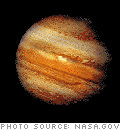Jupiter

 |
Jupiter is the largest planet in the solar system—a gaseous world as large as 1,300 Earths. Its equatorial diameter is 88,736 mi (142,800 km), while from pole to pole, Jupiter measures only 84,201 mi (133,500 km). For comparison, the diameter of Earth is 7,926.2 mi (12,756 km). The massive planet rotates at a dizzying speed—once every 9 hours and 55 minutes. It takes Jupiter almost 12 Earth years to complete a journey around the Sun.
The planet appears as a banded disk of turbulent clouds with all of its stripes running parallel to its bulging equator. Large dusky gray regions surround each pole. Darker gray or brown stripes called belts intermingle with lighter, yellow-white stripes called zones. The belts are regions of descending air masses and the zones are rising cloudy air masses. The strongest winds—up to 250 mph (400 km)—are found at boundaries between the belts and zones.
This uniquely colorful atmosphere is mainly 89% molecular hydrogen and 11% helium. It contains small amounts of methane, ammonia, ethane, and water.
Cloud-type lightning bolts similar to those on Earth have been found in the Jovian atmosphere. At the polar regions, auroras have been observed. A very thin ring of material less than 0.6 mi (1 km) in thickness and about 4,000 mi (6,000 km) in radial extent has been observed circling the planet about 35,000 mi (55,000 km) above the cloud tops.
The most prominent feature on Jupiter is its “Great Red Spot,” an oval larger than the planet Earth. It is a tremendous atmospheric storm that rotates counter-clockwise with one revolution every six days at the outer edge, while at the center almost no motion can be seen. The spot is about 16,000 mi (25,000 km) on its long axis, and would cover three Earths. Along the outer rim the winds blow at speeds reaching 225 mph (360 km/h).
Jupiter is circled by faint rings. They are very tenuous and contain many microscopic-sized particles. The rings are formed by dust kicked up as interplanetary meteoroids smash into the planet's four small inner moons.
Jupiter emits 67% more heat than it absorbs from the Sun. This heat is thought to have been accumulated during the planet's formation several billion years ago.
Twenty-one fragments of comet Shoemaker-Levy 9 bombarded the cloud-covered surface of Jupiter, July 16–22, 1994. It was the most violent event in the recorded history of our solar system. The impact of the comet fragments caused towering plumes of debris and hot gas to rise from the planet's surface.
On Dec. 7, 1995, the Galileo spacecraft released a probe into Jupiter's atmosphere to study the planet's physical and chemical properties. The probe lasted 57 minutes and early results indicated a lower abundance of water than was expected. Galileo data has shown that Jupiter has both wet and dry regions, just as Earth has tropics and deserts. This could explain why the probe found less water than anticipated. These dry spots cover less than 1% of the Jovian atmosphere. The Galileo mission ended on Sept. 21, 2003, when the probe made a scheduled crash into the gas giant.
 Schematic diagram of Jupiter's major features. Source: NASA. |







